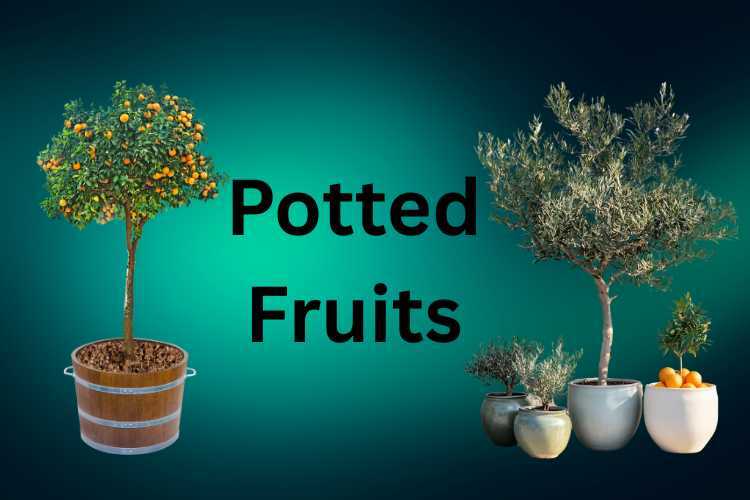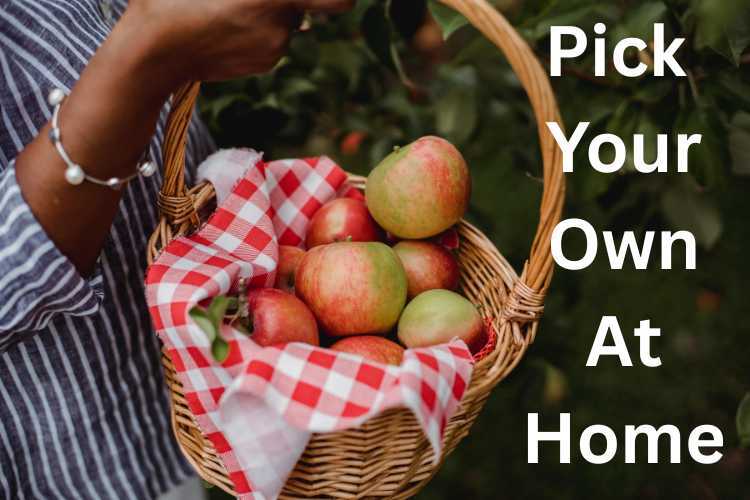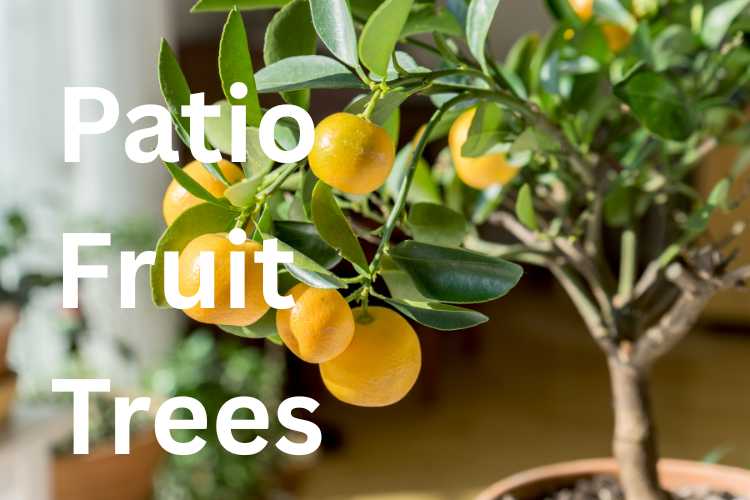Patio Fruit Trees for Small Gardens
30th Apr 2025
Who says you need acres of land to grow your own fruit? Every gardener, no matter the size of their garden, can grow their own fruit. Even the smallest patio, balcony, or courtyard can become a productive mini-orchard. With the right patio fruit trees—dwarf and container-friendly varieties—you can harvest apples, cherries, figs, and more without worrying about space, or the lack of it.
Why Choose Patio Fruit Trees?
Space Savers
Unsurprisingly patio trees stay compact. Most will only reach a height and spread of a few feet with a maximum of around six feet. The trees can be positioned anywhere so you can tuck them into a corner or line them along a fence. And of course, if they are planted in containers, they can be moved around anywhere you wish.
Dual Appeal: Ornamental & Edible
Many patio fruit trees look stunning. In spring you’ll enjoy seeing loads of blossom; in summer, lush foliage; and come autumn, masses of home-grown fruit. They’re a feast for the eyes as well as the taste buds.
Year-Round Interest
Fruit trees aren’t just for summer. And not just for producing fruit. Even in winter if they are trained on walls or espaliered against a fence, your patio fruit trees will look great and provide structure in your garden.
Understanding Dwarf Trees
What Makes Them “Dwarf”?
Patio fruit trees are grafted onto dwarfing rootstocks (e.g. M27 for apples) that limit their ultimate size. This of course makes them ideal for small gardens, patios, and even balconies.
How Big Do They Grow?
Well, as they are dwarf, they will of course be much shorter than other varieties of fruit trees. You can expect most patio apple and pear trees to top out at around 5 or 6 feet high. Dwarf cherries, figs, and other fruits can be even smaller, making them perfect for large containers or small plots.
Crop Yield vs. Tree Size
Bigger trees produce more fruit. Right? Well, yes and no. Smaller fruit trees and dwarf varieties often produce a similar per-square-metre yield when compared to full-sized trees. Even with a mini-orchard of dwarf trees you’ll still have a bumper harvest of fruit.
Top Patio Fruit Trees for Your Mini-Orchard
Of course, there are so many fruits to choose from, and many are available in dwarf varieties. You can see our full range of patio fruit trees here but many gardeners will want a mixture of trees in their mini-orchard. Unless you are very restricted for space in which case you could have a single self-fertile tree, such as a Victoria Plum.
Victoria Plum is probably the most popular fruit tree in the UK. The tree is easy to grow and a reliable cropper. The dwarf variety will only have a spread of 5x3 feet when fully mature and is perfect for the patio.
Pear trees are always popular and again Direct Trees have self-fertile dwarf varieties available. I must admit I prefer conference pears and grown on dwarf rootstock the tree will still reach six feet so will require a little more room that some other dwarf fruit trees.
Most of us will want at least one variety of apple tree in our garden. There are many to choose from but one which may be of interest is the good old Bramley apple. An absolute classic English fruit tree and will only grow to a maximum of five feet tall. Despite its small stature it will produce plenty of fruit and of course Bramleys are the best baking apples. Especially in apple crumbles.
Other varieties such as Granny Smiths and James Grieve are available as dwarf trees and are typical self-fertile so appeal to those gardeners who really do have minimum space in which to plant and grow their fruit trees.
One of the most popular patio fruit trees for small gardens are dwarf Japanese flowering cherry trees. These are wonderful trees and if you have several, they look amazing when in blossom. This was the first fruit tree that I grew. They are fully hardy and some are self-fertile. The only issue I had was birds making off with the cherries!
Designing Your Patio Mini-Orchard
Layout and Light
If possible, position your fruit trees where they’ll receive at least six hours of direct sun. Taller varieties go at the back or corners, with smaller ones in front to avoid shading.
Grouping for Impact
Cluster tree to five trees in a semicircle or along one side of the patio. This creates a cohesive “orchard” effect and looks fantastic too.
Layered Planting
Underplant trees with low-growing herbs (mint, thyme) or flowers for a colourful multi-level display.
Moveable Setup
If you’re planting in containers consider using wheeled plant stands or modular pots so you can move the pots around to rearrange your mini-orchard seasonally or to protect sensitive varieties in winter.
Choosing Containers & Soil Mix
There must be hundreds if not thousands of different pots and containers to choose from so I won’t be recommending specific pots. But here’s a few general guidelines to choosing the pots for your fruit trees.

Container Types
- Terracotta: Breathable and classic, but can crack in frost.
- Frost-proof Resin/Plastic: Lightweight, durable, and retains moisture.
- Wooden Half-Barrels: Attractive and insulating, but heavy when filled.
Size and Drainage
Aim for a minimum of 30–40 litres per tree. Ensure pots have plenty of drainage holes; elevate containers on feet or bricks to prevent waterlogging.
Potting Medium
Use a light, moisture-retentive mix (e.g. ericaceous/loam blend) enriched with well-rotted compost. It’s important to avoid using garden soil on its own. It can compact and suffocate roots.
Planting and Early Care
Position and Preparation
Place containers in your chosen layout. Fill pots two-thirds full, water to settle the mix, then insert the tree at the same depth as its nursery pot.
Backfill and Mulch
Top up with soil mix, firm around roots, then apply a 5 cm mulch layer (bark or compost) to conserve moisture and suppress weeds.
Initial Watering
Water thoroughly until it drains freely. For the first season, keep soil moist but not soggy.
Staking and Support
Even though they are shorter some patio fruit trees will benefit from a cane or stake; tie the trunk loosely to prevent wind-rock that can disrupt root establishment.
Pruning, Training, and Espalier Techniques
Basic Pruning Principles
You will need to do some basic maintenance with your trees including pruning in late winter or very early spring before the buds burst. When you prune be sure to remove crossing or congested branches. This will improve airflow and allow in more light.
Espalier and Fan Training
Not every can or will want to do this but if you’re able why not give it a go? Attach horizontal wires to a south facing wall, then tie shoots outwards at 30°–45° angles. This maximises fruiting spurs and can look spectacular.
Maintenance Trims
Light summer pruning can keep trees tidy and compact. Always remove no more than one-third of new growth at a time.
Feeding, Watering, and Seasonal Care
Fertiliser Schedule
Early Spring: Apply a balanced granular feed.
Post-Fruiting: Use a potash-rich feed to boost fruit quality.
Autumn: Lightly top-dress with compost or well-rotted manure.
Watering
It’s important to remember that containers dry out faster than ground soil. If you’re planting in pots water deeply when the top 2 cm feels dry—often every 2–3 days in summer, less in cooler months. For trees in the ground, you’ll need to water regularly until the tree is established and in warmer weather.
Winter Protection
For ground planted trees, fleece will protect your trees during cold spells. If you’re planting in containers, group your pots together, and wrap in bubble wrap or fleece. If you have citrus trees, consider moving them indoors or into an unheated greenhouse.
Troubleshooting Common Issues
Pests & Diseases
Aphids and Scale: Spray with a gentle insecticidal soap and monitor closely.
Apple Scab and Leaf Spot: Clean fallen leaves and improve airflow; use fungicide sprays if needed.
Brown Rot (Stone Fruit): Cut out the infected wood and avoid overhead watering.
Nutrient Deficiencies
If your tree’s leaves turn yellow this can often indicate and iron or nitrogen shortage. If this is the case feed the tree with an iron chelate spray or add a high-nitrogen fertiliser.
Let’s sum up. Transforming a small garden or patio into a fruit producing mini-orchard is not only achievable—it’s very rewarding. And very healthy too. By selecting dwarf or patio varieties of fruit trees, choosing the right containers, and positioning your trees for maximum sunlight, you’ll enjoy lovely displays of blossom and a bumper crop of apples, pears, cherries, or other fruit year after year.

Remember to monitor your trees through the seasons, and adjust watering and feeding as needed to keep them healthy. Be a little adventurous when planning your mini-orchard and don’t be afraid to experiment with espalier or grouping your containers. Even small tweaks—like underplanting with aromatic herbs or rotating pots to chase the sun—can deliver great results.
Ready to take the next step? Browse our large selection of patio fruit trees and take your time to pick the perfect varieties for your space and taste buds.


